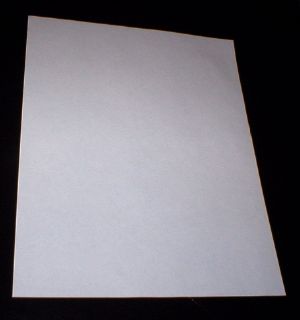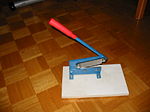Paper
Paper is a thin, flat material produced by the compression of fibers (or fibres). The fibers used are usually natural and composed of cellulose. The most common source of these fibers is wood pulp from pulpwood trees, (largely softwoods) such as spruce. However, other vegetable fiber materials including cotton, hemp, linen, and rice may be used. A stack of 500 sheets of paper is called a ream. Though generally considered a flexible material, the edges of paper sheets can act as very thin, fine-toothed saws, leading to paper cuts.
Manufacturing
Whether done by hand or with a machine, the paper-making process has three simple steps: preparation of the fibers, sheet formation, and drying.
Preparation of the fibers
The material to be used for making paper is first converted into pulp, which is a concentrated mixture of fibers suspended in liquid. The fiber is often obtained from natural sources, such as softwood or hardwood trees or other plants. Alternatively, recycled material may be used, such as old corrugated boxes, newsprint, or mixed paper.
To manufacture high-quality sheets of paper from plant material, it is usually necessary to break down lignin, a polymeric material that gives rigidity to the plant's cells walls. The breakdown of lignin is usually a chemical process, such as the Kraft process. This step is not needed when breaking down recycled fibers, as the lignin has already been removed from the source material. If lignin is retained in the pulp, the paper will yellow when exposed to air and light.
Alternatively, wood chips may be broken down mechanically, without using chemicals, to produce what is called "groundwood pulp." Because lignin is not removed from this pulp, yields are as high as 90–98 percent. The presence of lignin, however, causes paper to yellow. For this reason, groundwood pulp is most often used for non-permanent goods such as newspapers.
Pulp that is broken down chemically is known as "chemical pulp." The chemical pulping process breaks down the lignin and renders it soluble in a liquid (usually water), so it may be washed from the remaining fibers. Removing the lignin from wood chips also breaks them apart into the fibers that compose pulp.
Recycled fibers do not need to be pulped in the conventional sense. They have already been treated once, so they need a more gentle process to break the fibers apart while preserving their integrity.
Once the fibers have been extracted, they may be bleached or dyed, or special ingredients may be added to alter the appearance of the final product. For example, Kaolin (calcium carbonate) is added to produce the glossy papers typically used for magazines.
Sheet formation
The pulp mixture is further diluted with water resulting in a very thin slurry. This dilute slurry is drained through a fine-mesh moving screen to form a fibrous web. A watermark may be impressed into the paper at this stage of the process. This mark is used on paper currency and other things. This moving web is pressed and dried into a continuous sheet of paper.
In the mould process, a quantity of pulp is placed into a form, with a wire-mesh base, so that the fibers form a sheet on the mesh and excess water can drain away. Pressure may be applied to help remove additional water. The paper may then be removed from the mould, wet or dry, and go on to further processing.
Most mass-produced paper is made using the continuous Fourdrinier process to form a reel or web of fibers in a thin sheet. When dried, this continuous web may be cut into rectangular sheets by slicing the web vertically and horizontally to the desired size. Standard sheet sizes are prescribed by governing bodies such as the International Organization for Standardization (ISO).
Drying
After the paper web is produced, the water must be removed from it in order to create a usable product. This is accomplished through pressing and drying. The methods of doing so vary between the different processes used to make paper, but the concepts remain the same.
Pressing the sheet removes the water by force. Once the water is forced from the sheet, another absorbant material must be used to collect this water. On a paper machine this is called a felt (not to be confused with the traditional felt). When making paper by hand, a blotter sheet is used.
Drying involves using air and or heat to remove water from the paper sheet. In the earliest days of papermaking this was done by hanging the paper sheets like laundry. In more modern times, various forms of heated drying mechanisms are used. On the paper machine, the most common is the steam-heated can dryer. These dryer cans heat to temperatures above 200ºF and are used in long sequences of more than 40 cans. The heat produced by these can easily dry the paper to less than 6% moisture.
Applications
- To write or print on: the piece of paper becomes a document; this may be for keeping a record (or in the case of printing from a computer or copying from another paper: an additional record) and for communication; see also reading.
- To represent a value:
- paper money
- bank note
- check
- security
- voucher
- ticket
- For entertainment:
- For packaging:
- envelope
- wrapping tissue
- wallpaper
- For cleaning (see also tissue, Kleenex):
- toilet paper
- handkerchiefs
- paper towels
- cat litter
- For construction
- papier-mâché
- origami
- quilling
- paper machines- paper-engineering
- Other uses
- emery paper
- sandpaper
- blotting paper
- Litmus paper
History
The word paper comes from the ancient Egyptian writing material called papyrus, which was woven from papyrus plants. Papyrus was produced as early as 3000 B.C.E. in Egypt, and in ancient Greece and Rome. Further north, parchment or vellum, made of processed sheepskin or calfskin, replaced papyrus, as the papyrus plant requires subtropical conditions to grow. In China, documents were ordinarily written on bamboo, making them very heavy and awkward to transport. Silk was sometimes used, but was normally too expensive to consider. Indeed, most of the above materials were rare and costly.
The Chinese court official Cai Lun described the modern method of papermaking in AD 105; he was the first person to describe how to make paper from cotton rags. Other sources trace the invention of this type of papermaking to China in 150 B.C.E. It spread slowly outside of China; other East Asian cultures, even after seeing paper, could not figure out how to make it themselves. Instruction in the manufacturing process was required, and the Chinese were reluctant to share their secrets. The technology was first transferred to Korea in 600 and then imported to Japan by a Buddhist priest, Dam Jing (曇徴) from Goguryeo, around 610, where fibres (called bast) from the mulberry tree were used. After further commercial trading and the defeat of the Chinese in the Battle of Talas, the invention spread to the Middle East, where it was adopted in India and subsequently in Italy in about the 13th century. They used hemp and linen rags as a source of fiber. The oldest known paper document in the West is the Missel of Silos from the 11th century.
Some historians speculate that paper was the key element in global cultural advancement. According to this theory, Chinese culture was less developed than the West in ancient times because bamboo, while abundant, was a clumsier writing material than papyrus; Chinese culture advanced during the Han Dynasty and preceding centuries due to the invention of paper; and Europe advanced during the Renaissance due to the introduction of paper and the printing press.
Paper remained a luxury item through the centuries, until the advent of steam-driven paper making machines in the 19th century, which could make paper with fibres from wood pulp. Although older machines predated it, the Fourdrinier paper making machine became the basis for most modern papermaking. Together with the invention of the practical fountain pen and the mass produced pencil of the same period, and in conjunction with the advent of the steam driven rotary printing press, wood based paper caused a major transformation of the 19th century economy and society in industrialized countries. Before this era a book or a newspaper was a rare luxury object and illiteracy was the norm. With the gradual introduction of cheap paper, schoolbooks, fiction, non-fiction, and newspapers became slowly available to nearly all the members of an industrial society. Cheap wood based paper also meant that keeping personal diaries or writing letters ceased to be reserved to a privileged few. The office worker or the white-collar worker was slowly born of this transformation, which can be considered as a part of the industrial revolution.
Unfortunately, the original wood-based paper was more acidic and more prone to disintegrate over time, through processes known as slow fires. Documents written on more expensive rag paper were more stable. The majority of modern book publishers now use acid-free paper.
Recent developments
Paper made in the west since the industrial revolution has been almost exclusively wood based, except for a few specialized papers like those used in banknotes. However, at least one company (Cloudy Bay Cotton) has recently tried to introduce cotton based tissue papers to westernised countries as an alternative to wood based ones. Their reasons for doing this are that the cotton based tissue papers are less abrasive, less likely to cause allergic reactions, and far more environmentally friendly than wood papers, as they are made from renewable materials. The type of cotton fibres used for making paper are discarded as unusable waste from the textile industry, and can be manufactured using fewer chemicals and less energy.
Some manufacturers, notably AMD, have started using a new, slightly more environmentally friendly alternative to expanded plastic packaging made out of paper, known commercially as "paperfoam." The packaging has very similar mechanical properties to some expanded plastic packaging, but is biodegradable and can also be recycled with ordinary paper. [1]
With increasing environmental concerns about synthetic coatings (such as PFOA) and the currently higher prices of hydrocarbon based petrochemicals, there is a recent focus on zein (corn protein) as a coating for paper in high grease applications such as popcorn bags. [2]
See also
- Electronic paper
- Kaolin
- newspaper
- cardboard
- foxing
- ISO 216
- ISPM 15
- newsprint
- paper sizes
- paper mill
- paper recycling
- pulp and paper industry
- stationery
- substrate (printing)
- washi
- Tracing paper
External links
- How is paper made? at The Straight Dope, 22 November 2005
- No End to Paperwork
- Paper Online
- How Paper Is Made
- United States Government Printing Office: Government Paper Specification Standards
- History of Paper Making
- Definition of paper
Credits
New World Encyclopedia writers and editors rewrote and completed the Wikipedia article in accordance with New World Encyclopedia standards. This article abides by terms of the Creative Commons CC-by-sa 3.0 License (CC-by-sa), which may be used and disseminated with proper attribution. Credit is due under the terms of this license that can reference both the New World Encyclopedia contributors and the selfless volunteer contributors of the Wikimedia Foundation. To cite this article click here for a list of acceptable citing formats.The history of earlier contributions by wikipedians is accessible to researchers here:
The history of this article since it was imported to New World Encyclopedia:
Note: Some restrictions may apply to use of individual images which are separately licensed.


